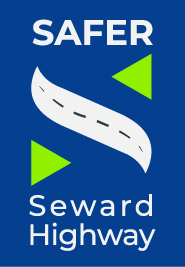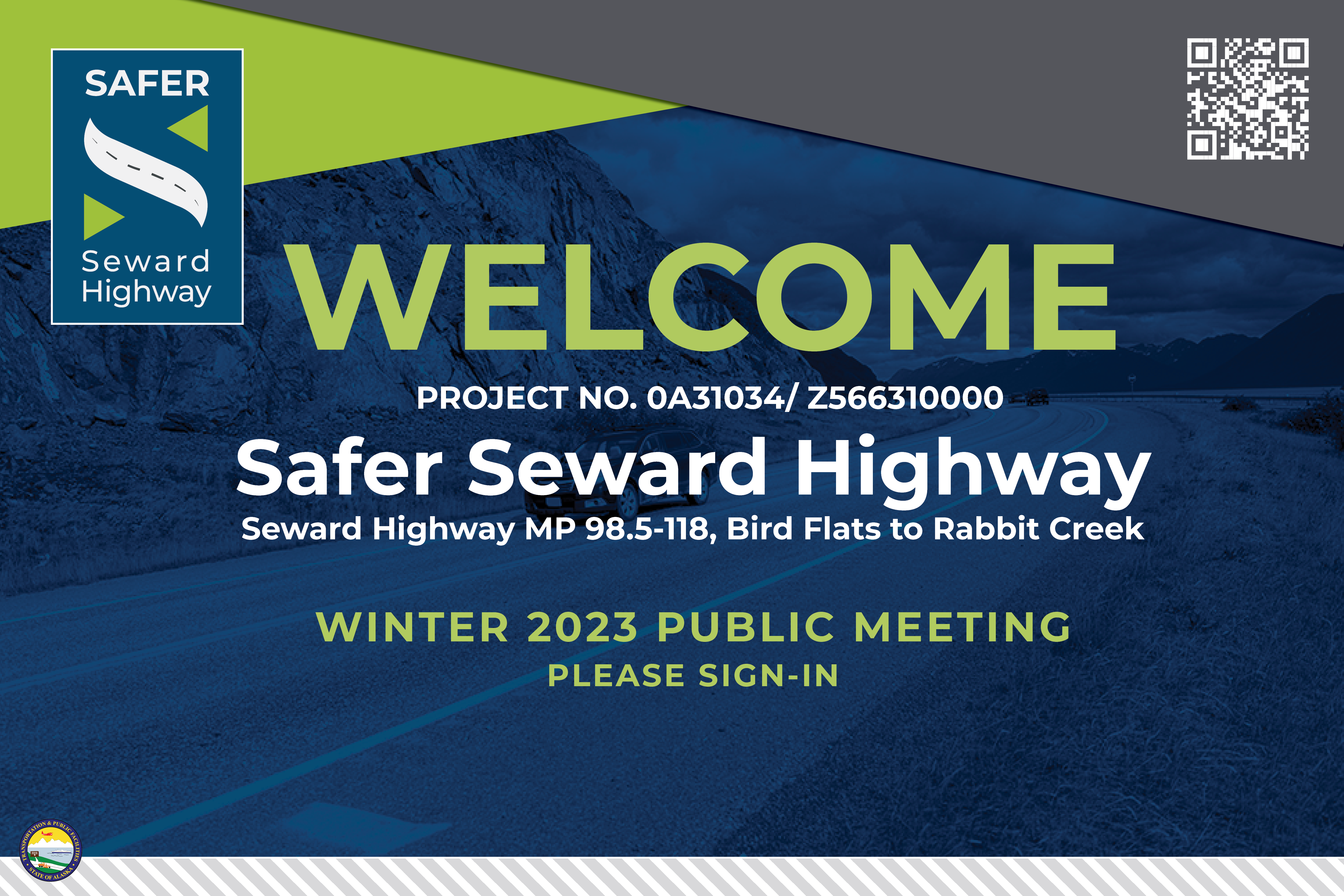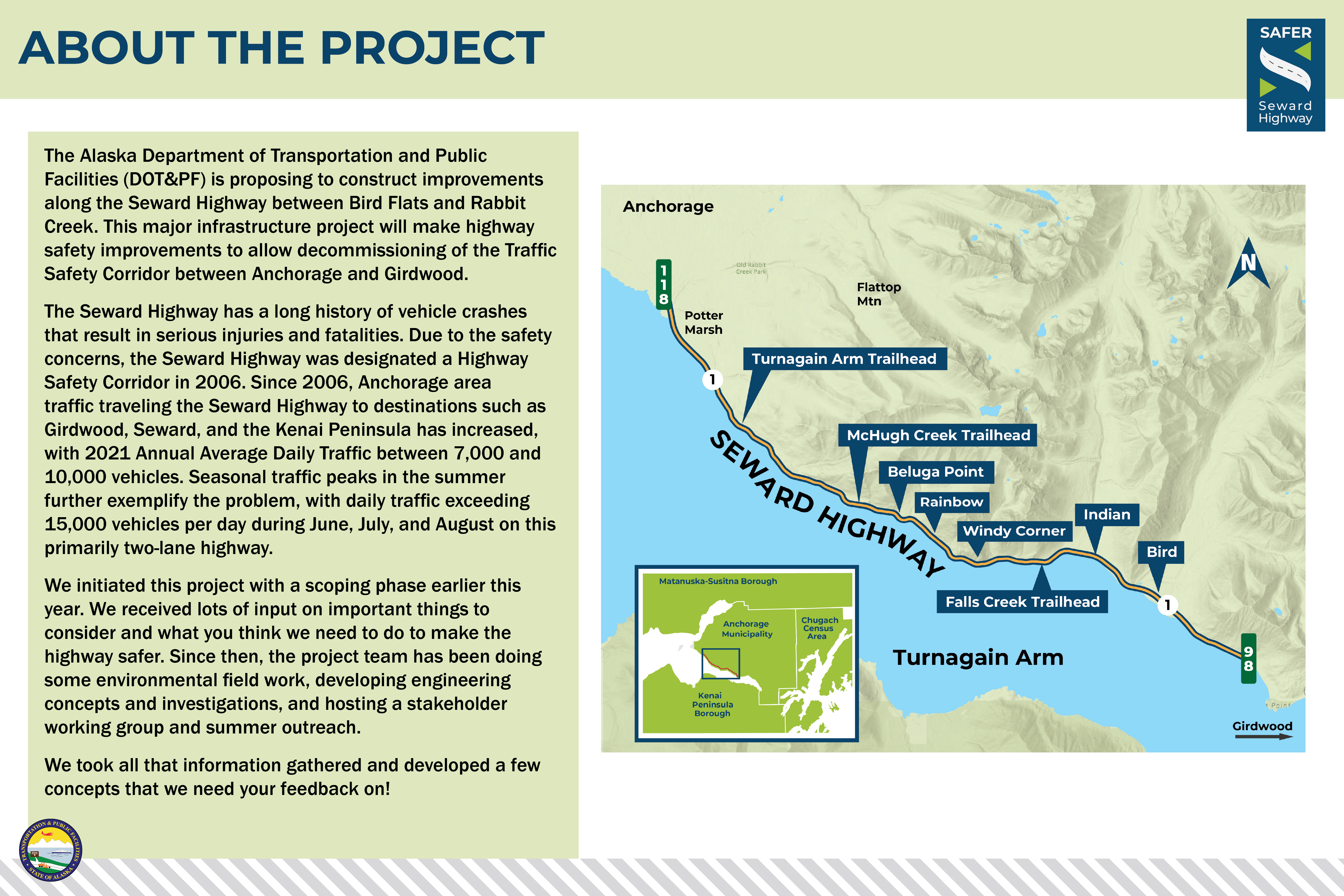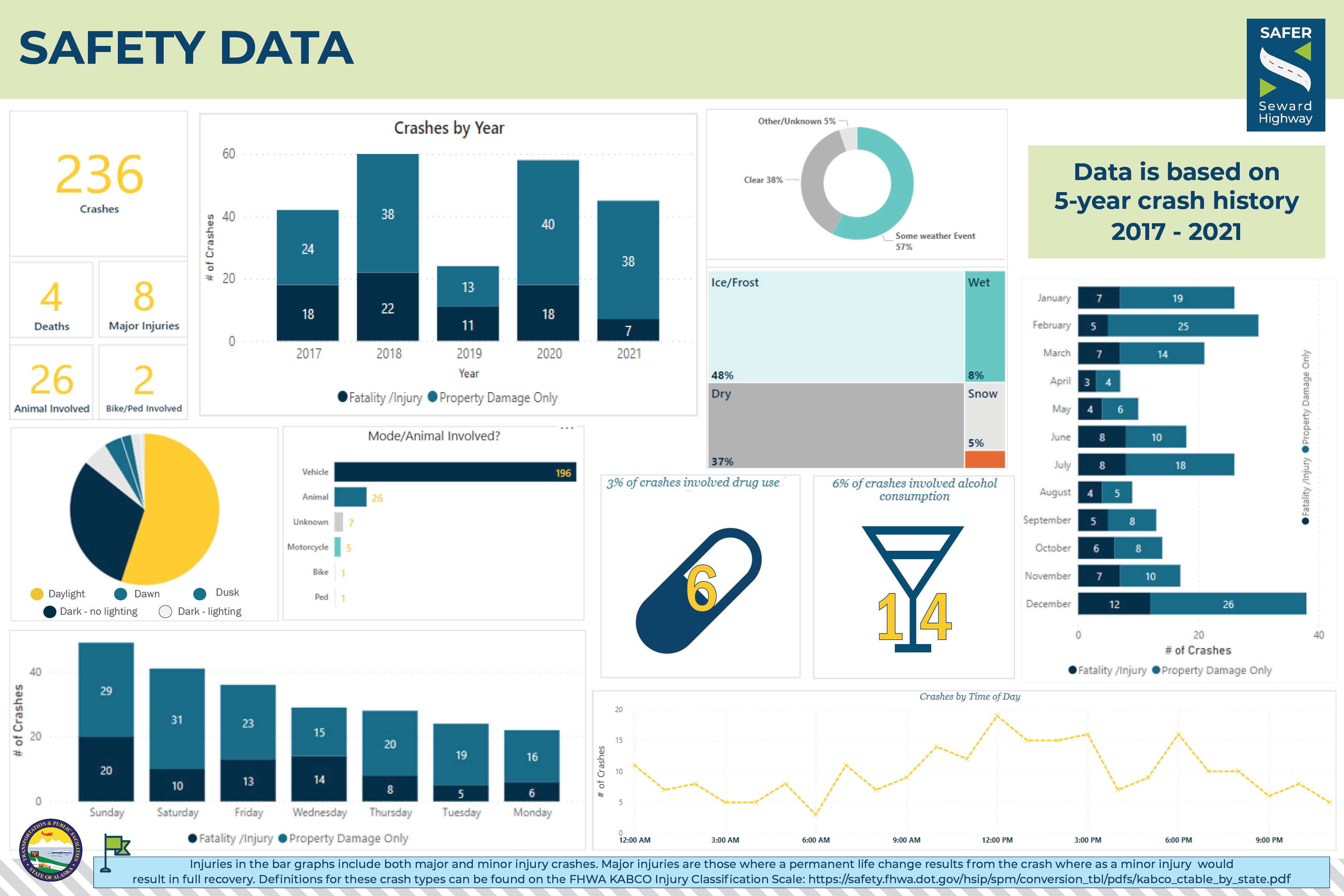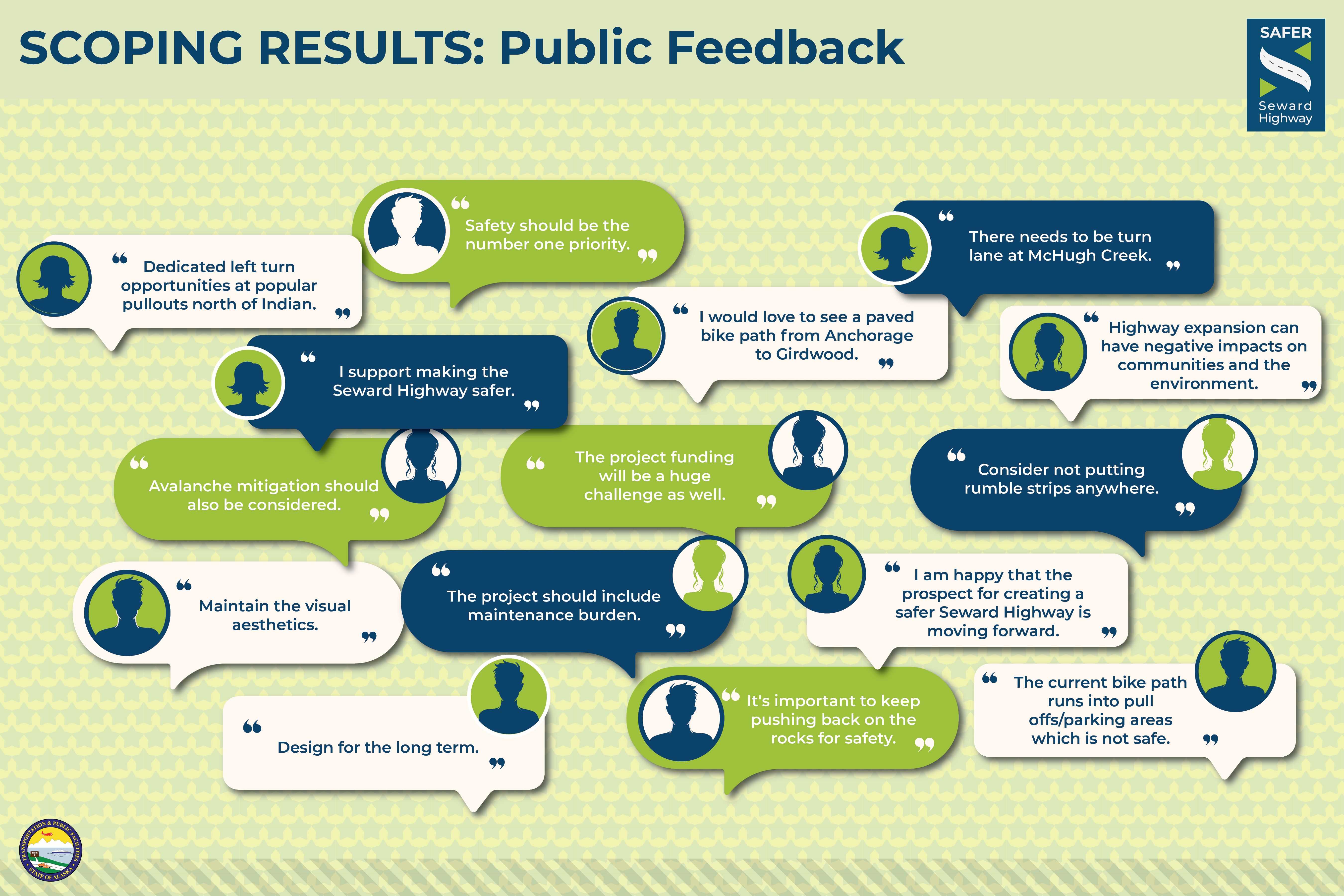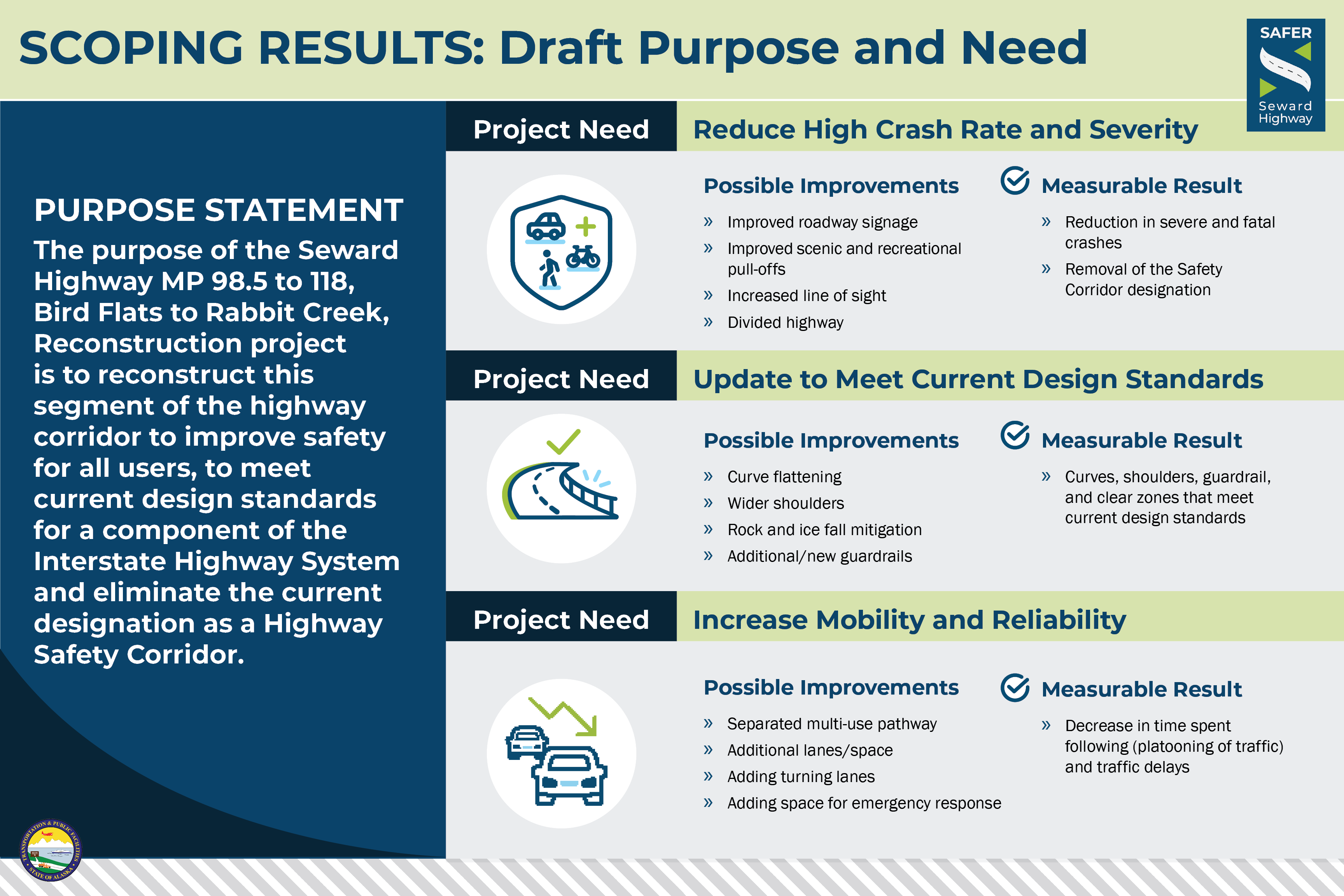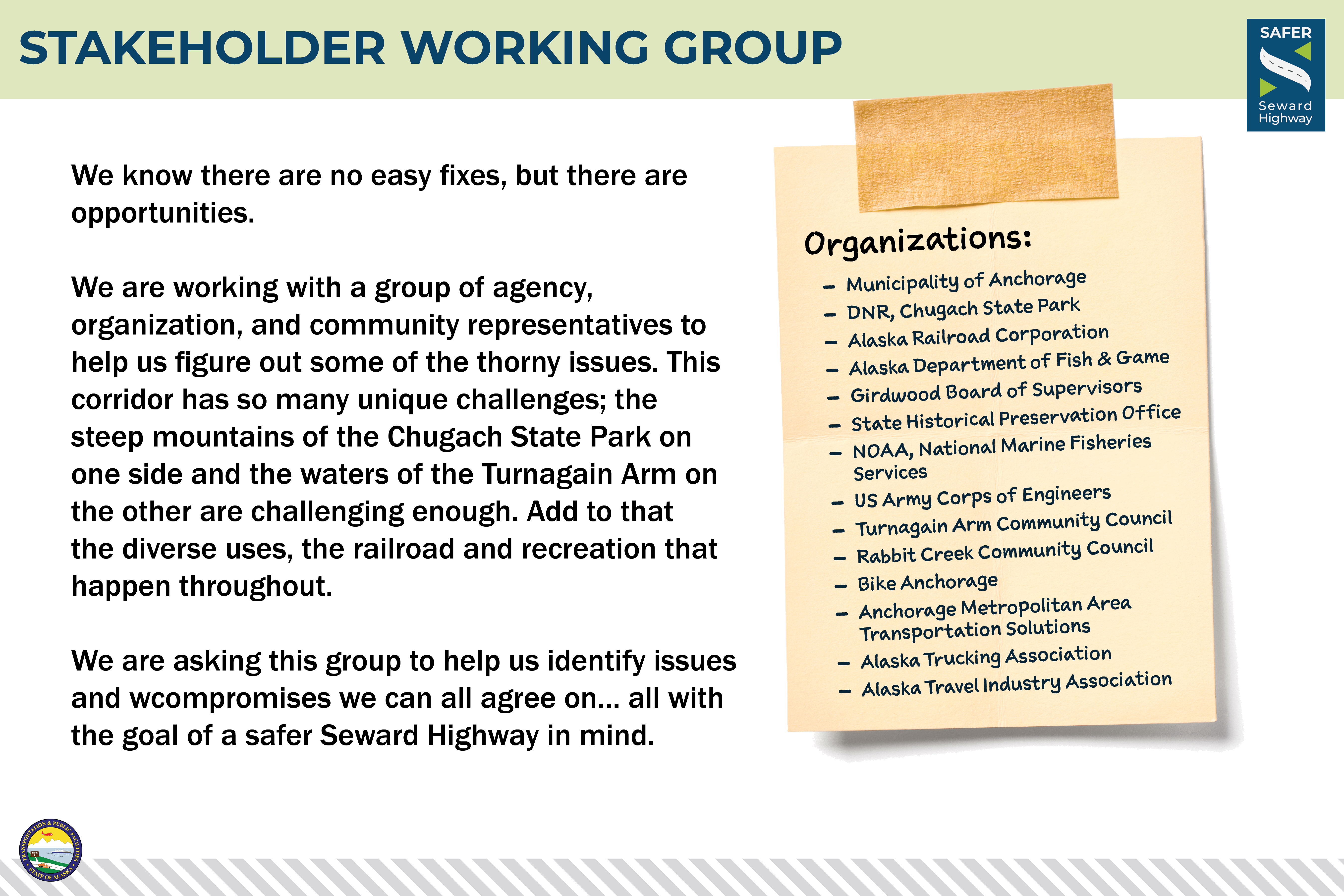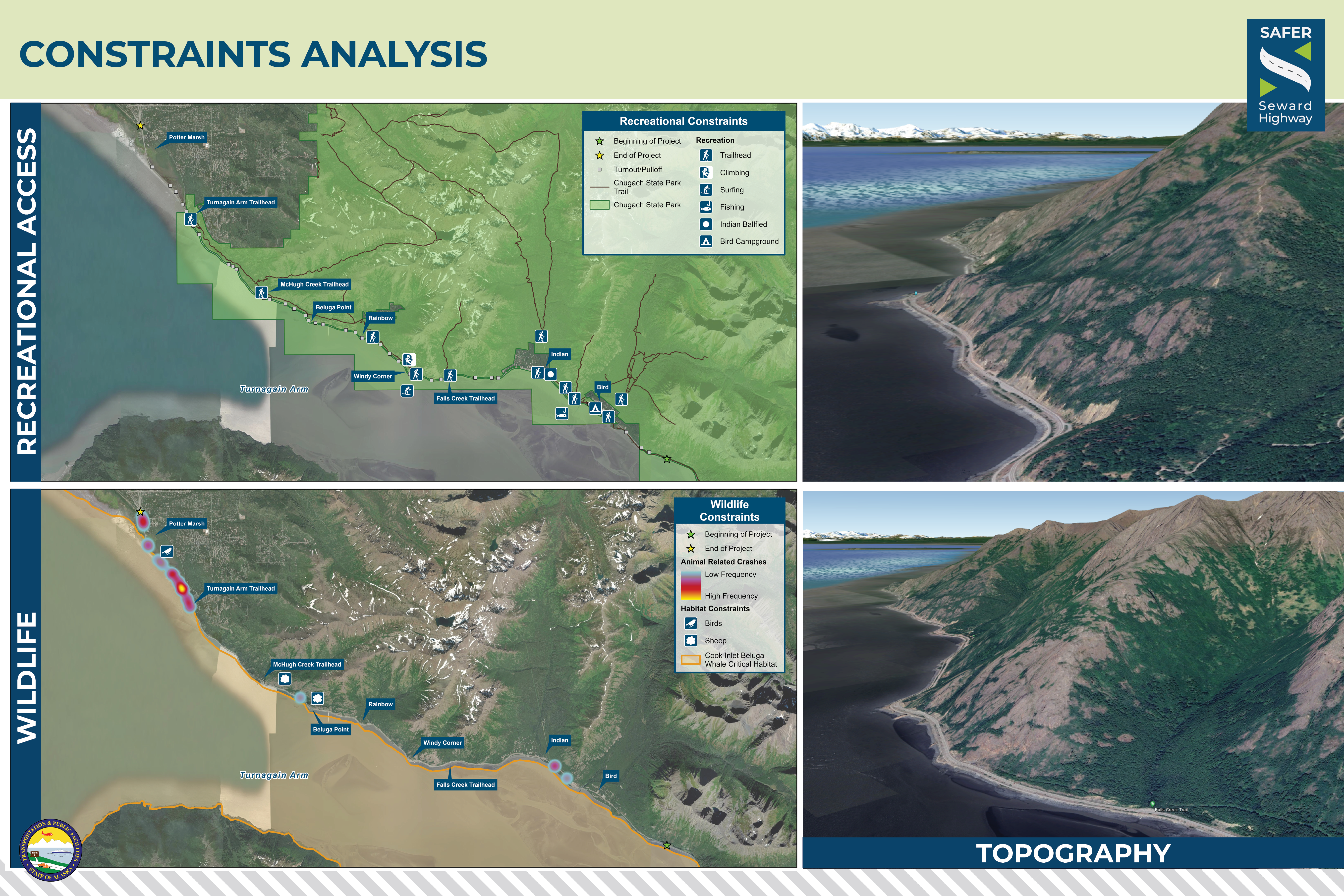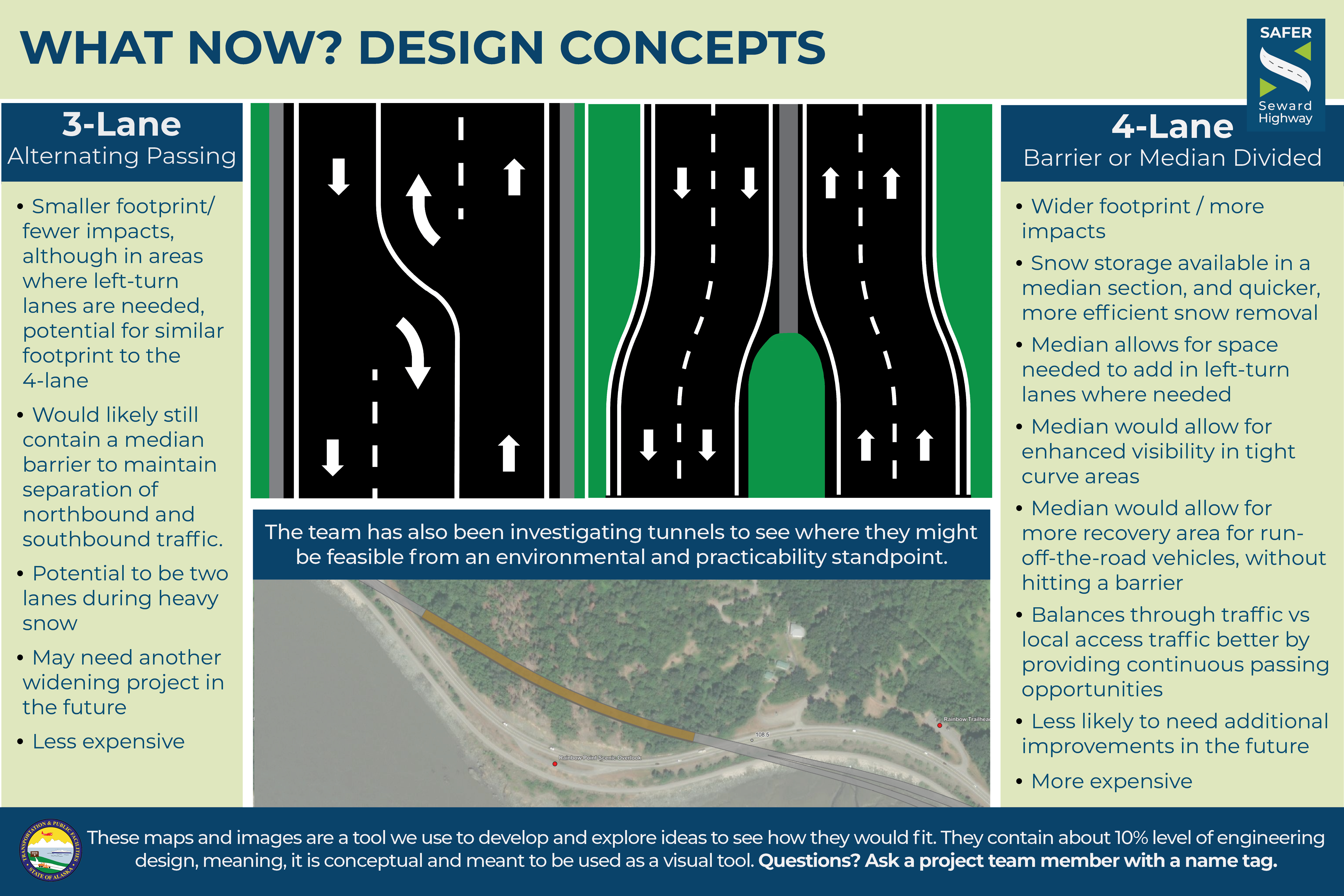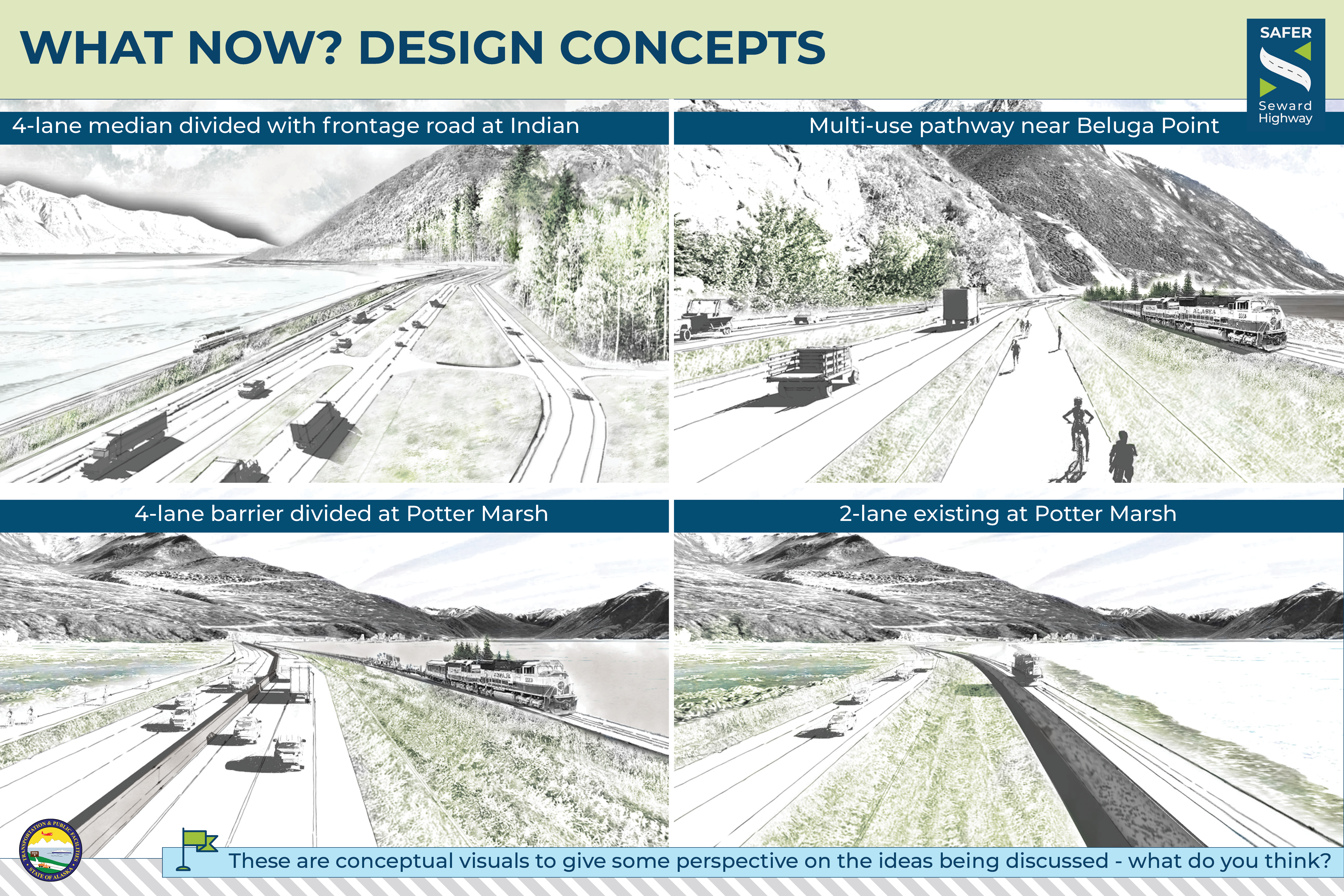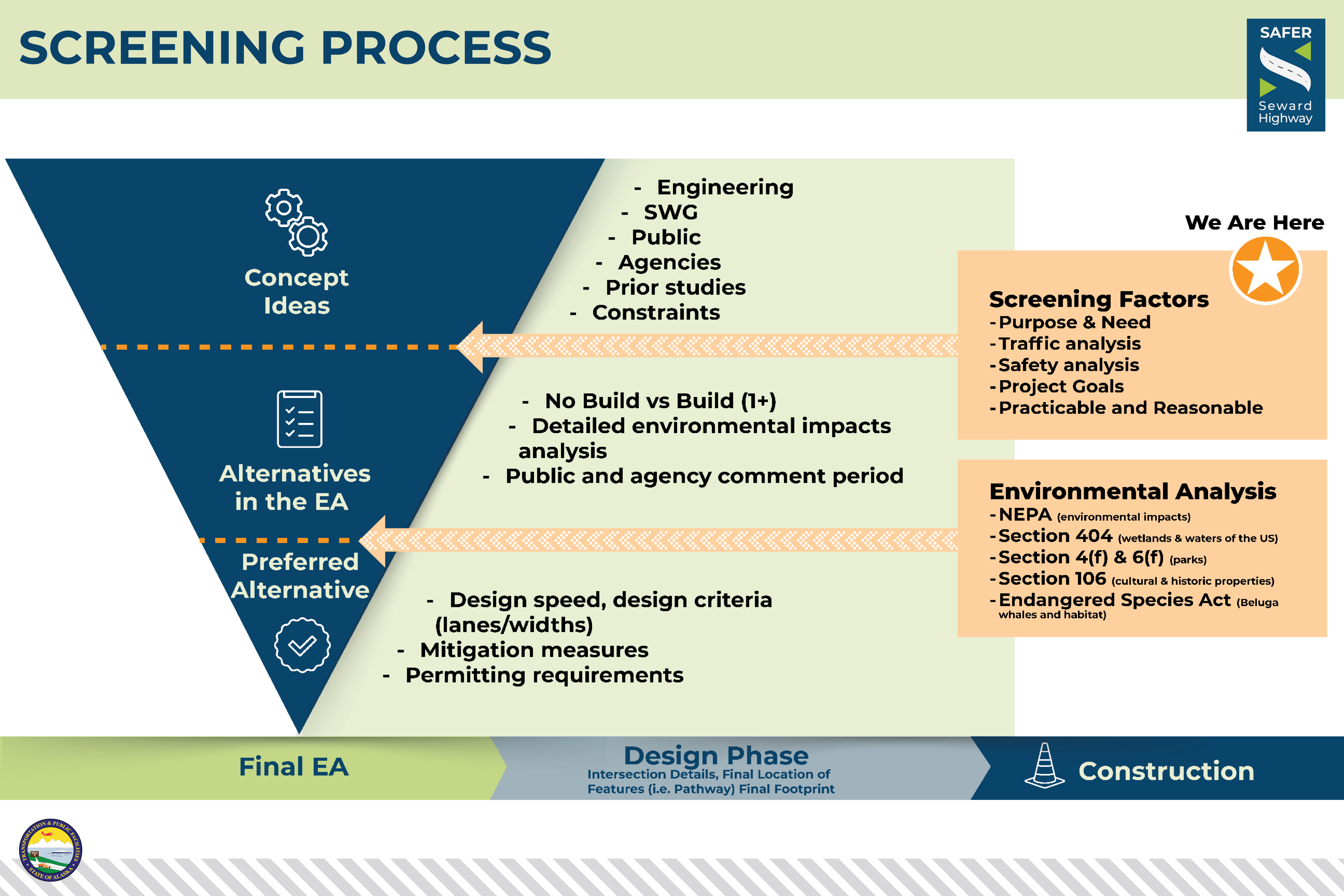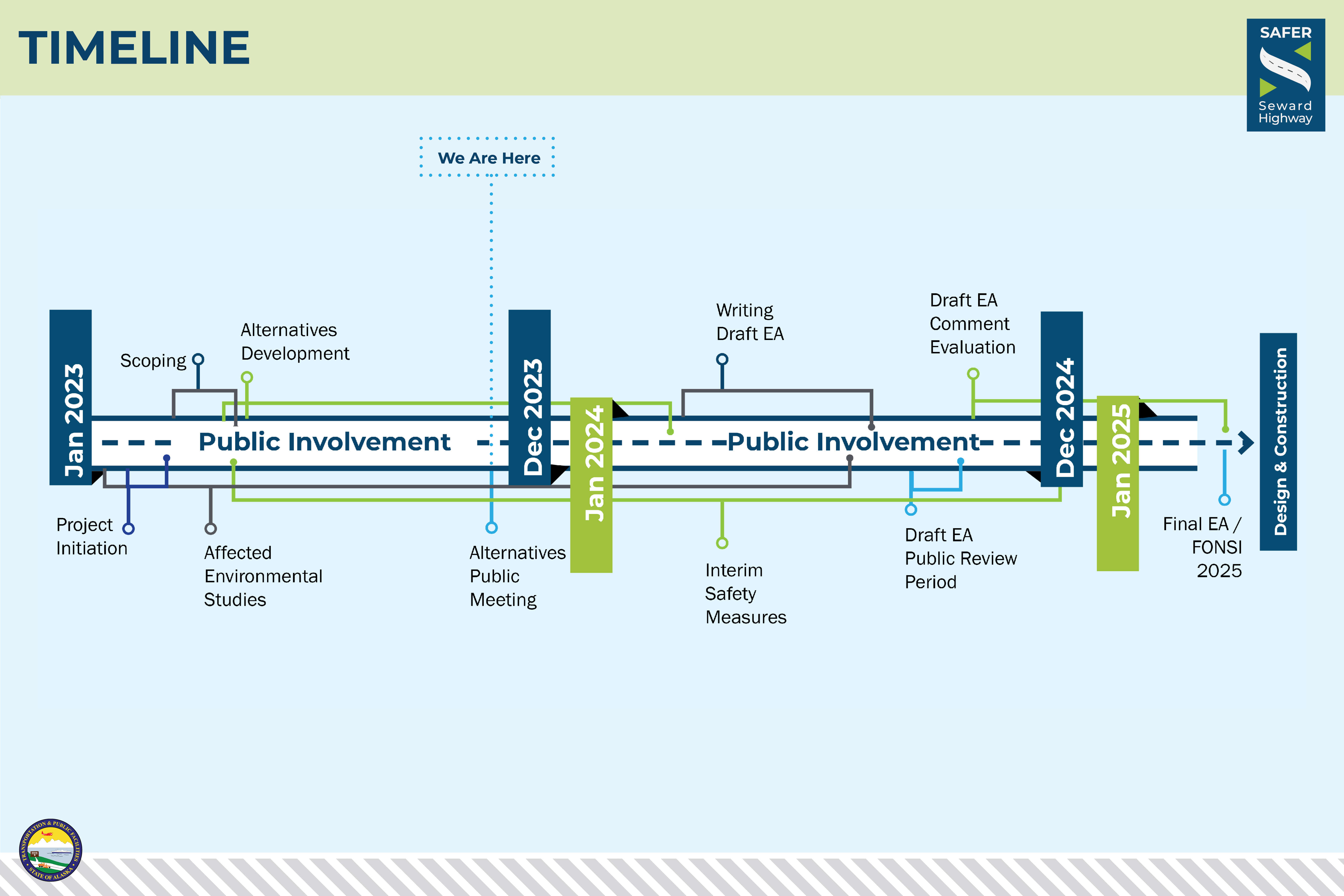ARCHIVED
Welcome to the Safer Seward Highway
Winter 2023 Online Open House
Available December 5, 2023 – January 4, 2024
Seward Highway MP 98.5–118, Bird Flats to Rabbit Creek | Project No. 0A31034/ Z566310000
*** THIS ONLINE OPEN HOUSE IS NOW CLOSED. THANK YOU FOR YOUR PARTICIPATION* **
The purpose of this Online Open House is to share information regarding the project that was presented at the December 2023 Public Meetings.
Navigating this site (side of text above)
This site is best viewed on your desktop or laptop computer at 100% view. You may scroll down using your mouse to view each station at your leisure or use the left navigation pane to skip to different stations. If you prefer to experience this Online Meeting in text format only, visit the Text Only page of this meeting.
Navigating this site
This site is best viewed on your desktop or laptop computer at 100% view. You may scroll down using your mouse to view each station at your leisure, use the dot navigation at the right of your screen or use the left navigation pane to skip to different stations.
Welcome
Thank you for joining us!
The information presented during this Online Open House mirrors the information presented at the three 2023 Public Meetings held in Girdwood, Indian, and Anchorage, Alaska.
We would like to give an update on the feedback we have received and what we’ve been working on. The project team has put together a few initial concepts, and we would like to get your feedback on them.
About the Project
DOT&PF has proposed improvements along the Seward Highway between Bird Flats and Rabbit Creek. This project aims to make long, term, permanent corridor improvements which will allow removal of the traffic safety corridor designation between Anchorage and Girdwood.
This map shows the Seward Highway and its constraints, caused by its position between the steep slopes of the Chugach Mountains and the waters of the Turnagain Arm inlet, which make this section of highway particularly challenging to improve. We recognize the value of this 20, mile stretch of road to Alaskans and visitors to our state, with its world, class scenic views, wildlife, and recreational areas of Chugach State Park. Currently, we are in the early stages of this new project, which begins with environmental scoping, studies, and assessment of impacts. This process will lead to the design, development, and ultimately construction of long, term improvements.
Safety Data
The project team has begun a safety and traffic analysis of the corridor to help us discover the primary drivers of crashes. This analysis is still in the works but here are some preliminary numbers and some key observations:
- The majority of crashes occur in daylight
- Drugs and alcohol are not significant factors in crashes
- December, February and July have the highest rates of crashes
- Most crashes occur on the weekend
- Weather has a significant impact on crashes
Scoping Results: Public Feedback
What have we heard so far? We’ve heard some specific needs, many thoughts about the vision for the corridor, and much more! But one thing we wanted to highlight is that we received quite a bit of feedback on what the goals of this project should be. We shared a draft purpose and need statement during scoping, and received good public feedback. Thanks for sharing your thoughts with us. They are shaping the studies underway and our understanding of problem areas.
Scoping Results: Purpose and Need
The project intends to address three needs:
Reduce High Crash Rate and Severity
In 2006, this segment of the Seward Highway was designated as the state’s first Highway Safety Corridor in recognition of the fatal crash rate at that time. Despite additional enforcement presence, community education and improved signage, segments still have a higher-than-average crash rate and severity. Improvements that reduce the crash rate must be completed to remove the Safety Corridor designation. This need includes improving safety for non-motorized users in the corridor.
Update to Meeting Current Design Standards
The existing highway does not meet current design standards for its function and traffic levels. The existing highway contains curves, shoulders, guardrails, and clear zones that do not meet current design standards. Both highway and non-motorized facility improvements need to be built to current state and national design standards.
Increase Mobility and Reliability
This highway corridor serves both regional users, who travel between Anchorage and the Kenai Peninsula, and local users, who live and work in the communities along this segment of the Seward Highway. The highway becomes congested resulting in reduced travel speeds, long platoons (lines) of vehicles, and a degraded level of service. Unexpected delays affect all travelers, reducing the reliability of travel during periods of congestion and roadway closures. Non-motorized users lack reliable, safe, continuous facilities in this corridor. Improvements need to increase travel mode choices and the reliability and accessibility of facilities.
Stakeholder Working Group
The stakeholder working group has been key in helping us to develop these concepts. We have met six times as a group, and once or twice more individually with many of these stakeholder organizations. These organizations were selected to represent major user groups in the corridor, as well as agencies and organizations that are part of the environmental process. Agencies such as NOAA and the US Army Corps of Engineers have certain requirements and considerations we must include, and it helps to have everyone in the same room to discuss because each group has different viewpoints for us and for each other to consider.
Constraints Analysis
There are a lot of constraints we are balancing. We spent quite a bit of time this summer looking at the corridor and what physical constraints are present. These are three key areas of physical constraints we have looked at: recreation, wildlife and topography. Our understanding of recreational access points comes from the Chugach State Park, databases, reports, and talking with the public. Additionally, this is also a wildlife rich environment, with sheep and moose as the two primary types of wildlife we see along the corridor. We have met with the Alaska Department of Fish and Game to identify key wildlife habitats, and have also looked at the crash data to see where high rates of wildlife conflict occur. We have mapped out both the recreational and wildlife constraints. The third type of constraint we studied was the topography of the corridor. The topography plays a large role in our concept development and ultimately, what will be able to be build.
What Now? Design Concepts
We have two concepts that have risen to the surface through our investigation and design: a 3-lane and a 4-lane. We will go into some detail about the specific pinch points along the corridor but when we talk generally about the 3-lane and 4-lane, we want to bring up a few overall points.
The map below is an interactive tool that the team refers to as “the sandbox”. On the left-hand side inside the map, you will see a 4-lane concept and a 3-lane concept drop down. Click the eyeball next to the concept you would like to view to turn it on and off. Below the concepts there are a few other levels that you can turn on and off; cadastral (right of way), hydrology, and base layers. Base layers allows you to view things like trails, where the refuge starts and stops, and locations of existing Chugach State Park facilities. You can turn on turn on all the layers by clicking the eyeball at the top of the drop down or by selecting the individual eyeballs in the drop-down options.
Again, this is meant to be a visual tool we’ve been working on to share concept level engineering to date for public feedback.
What Now Design Concepts – Three Lane and Four Lane Alternatives Visuals
Now when we say “median divided” versus “barrier divided,” what does that mean? Here are some very conceptual level sketches to show you how that might look. Starting at the top left, we have a sketch of what a 4-lane median divided with a frontage road might look like at Indian looking north.
Moving clockwise, the top right image portrays a concept for the multi, use pathway near Beluga Point. We wanted to provide a perspective of being on the pathway to show what putting the pathway in with the road and railroad might look like. The distance between the road and the pathway has not yet been established, but this is what we are currently working with for the very tight spots along the corridor. We’ve also heard that it would be more desirable to have the pathway on the water side with access to some of the mountainside trails. Right now, we are just establishing the footprint, and the pathway could be moved to either side.
The two bottom images represent the same perspective at Potter marsh with the right side showing what currently exists, and the left side showing what a 4-lane barrier divided concept would look like. We wanted to show both images side by side for comparison. Based on our discussions in the working groups, it looks like moving out to the mud flats is going to be the best option so that we avoid impacts to Potter Marsh. With a 4-lane through here, the northbound lanes would be built where the existing road is today, and the railroad and southbound lanes would move west out on fill in the mud flats. The other thing to highlight in these sketches is the pathway shown on the Potter Marsh side.
Pinch Points
Choose the tabs below to view pinch points for each project area segment.
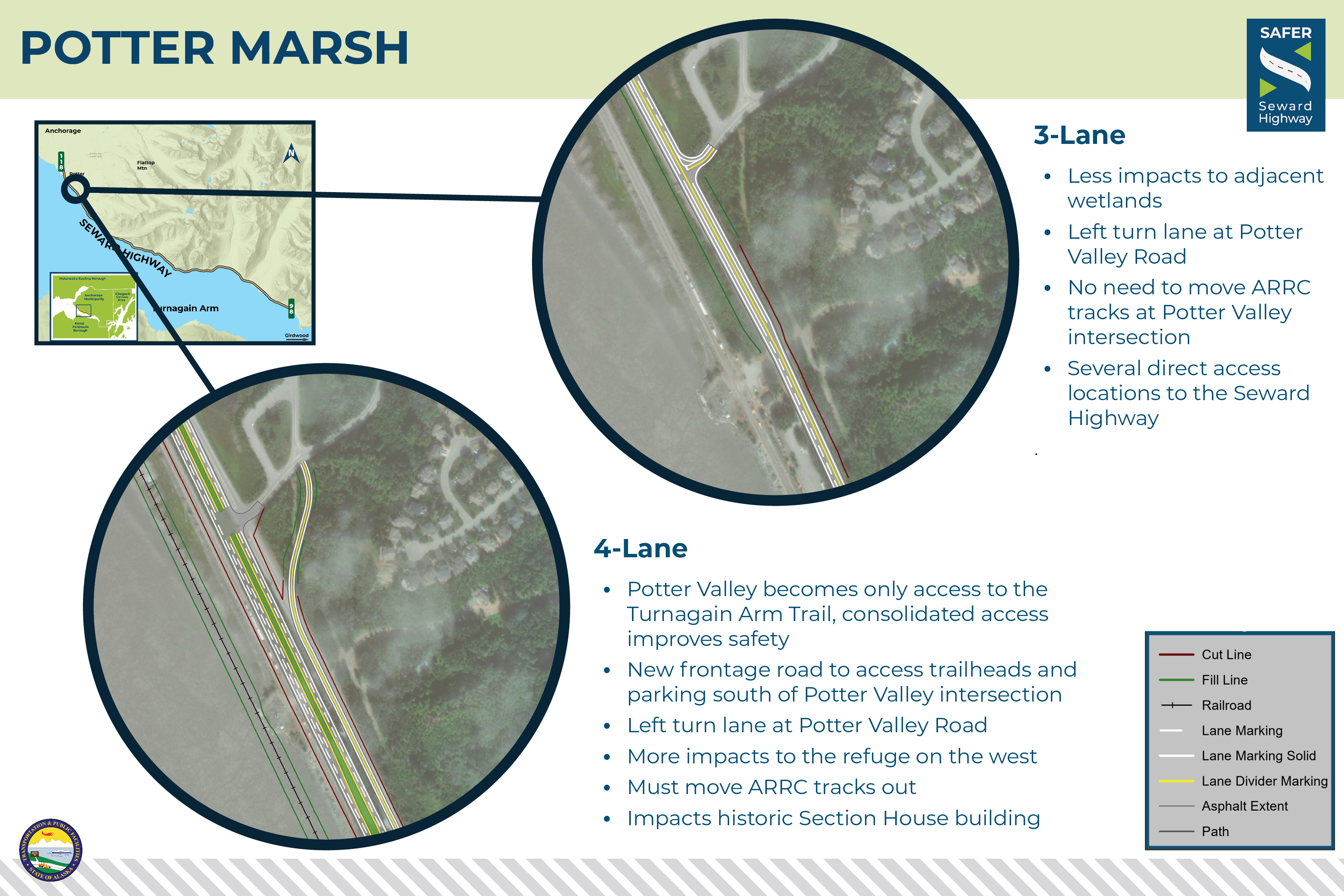
Potter Marsh
The Potter Marsh pinch point shows a diagram comparing 3-lanes and 4-lanes in the area.
3-Lane
- Less impacts to adjacent wetlands
- Left turn lane at Potter Valley Road
- No need to move ARRC tracks at Potter Valley intersection
- Several direct access locations to the Seward Highway
4-Lane
- Potter Valley becomes only access, consolidated access improves safety
- New frontage road to access trailheads and parking, south of Potter Valley intersection
- Left turn lane at Potter Valley road
- More impacts to the refuge on the west
- Must move ARRC tracks out
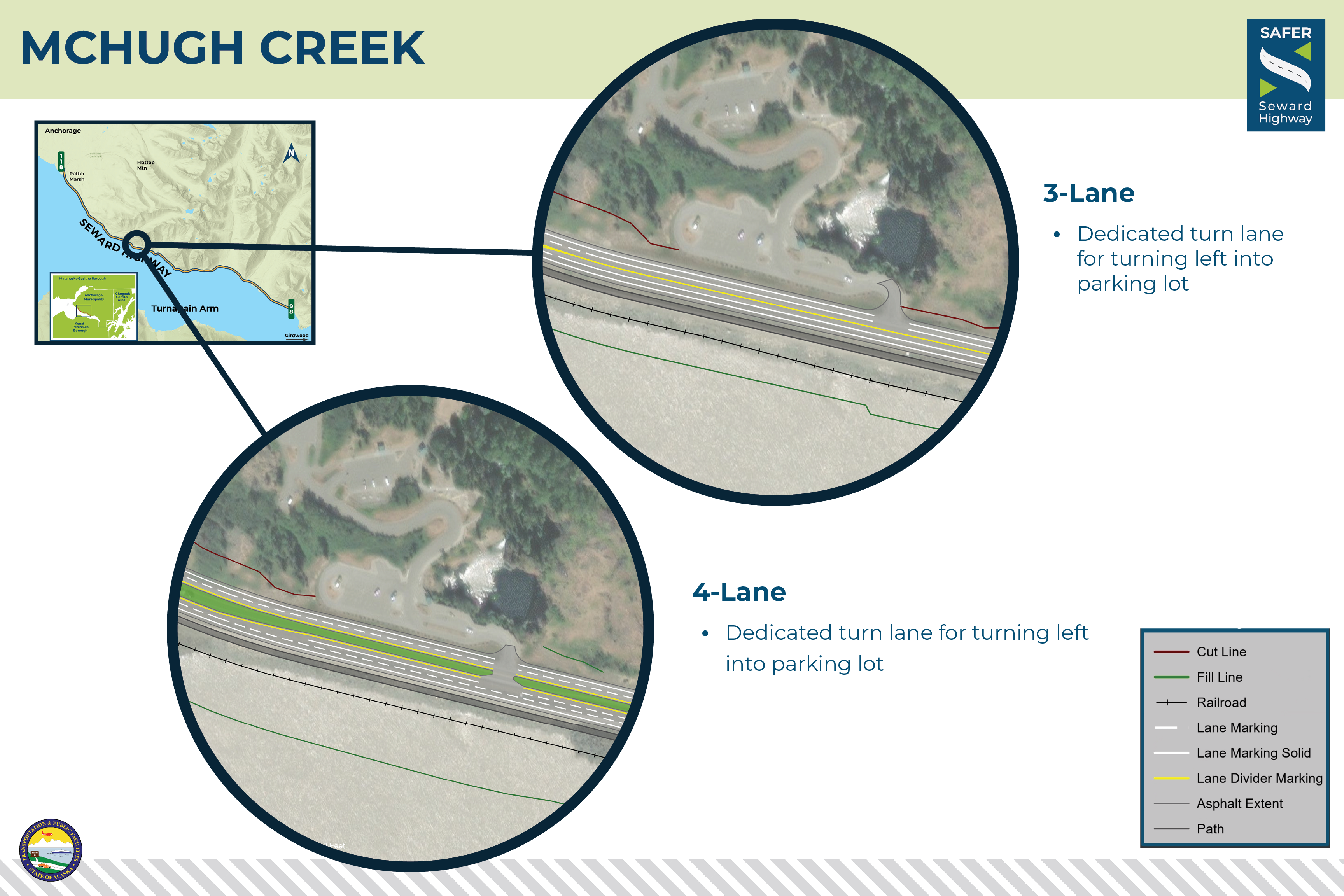
McHugh Creek
The McHugh Creek pinch point shows a diagram comparing 3-lanes and 4-lanes in the area.
3-Lane
- Dedicated turn lane for turning left into parking lot
4-Lane
- Dedicated turn lane for turning left into parking lot
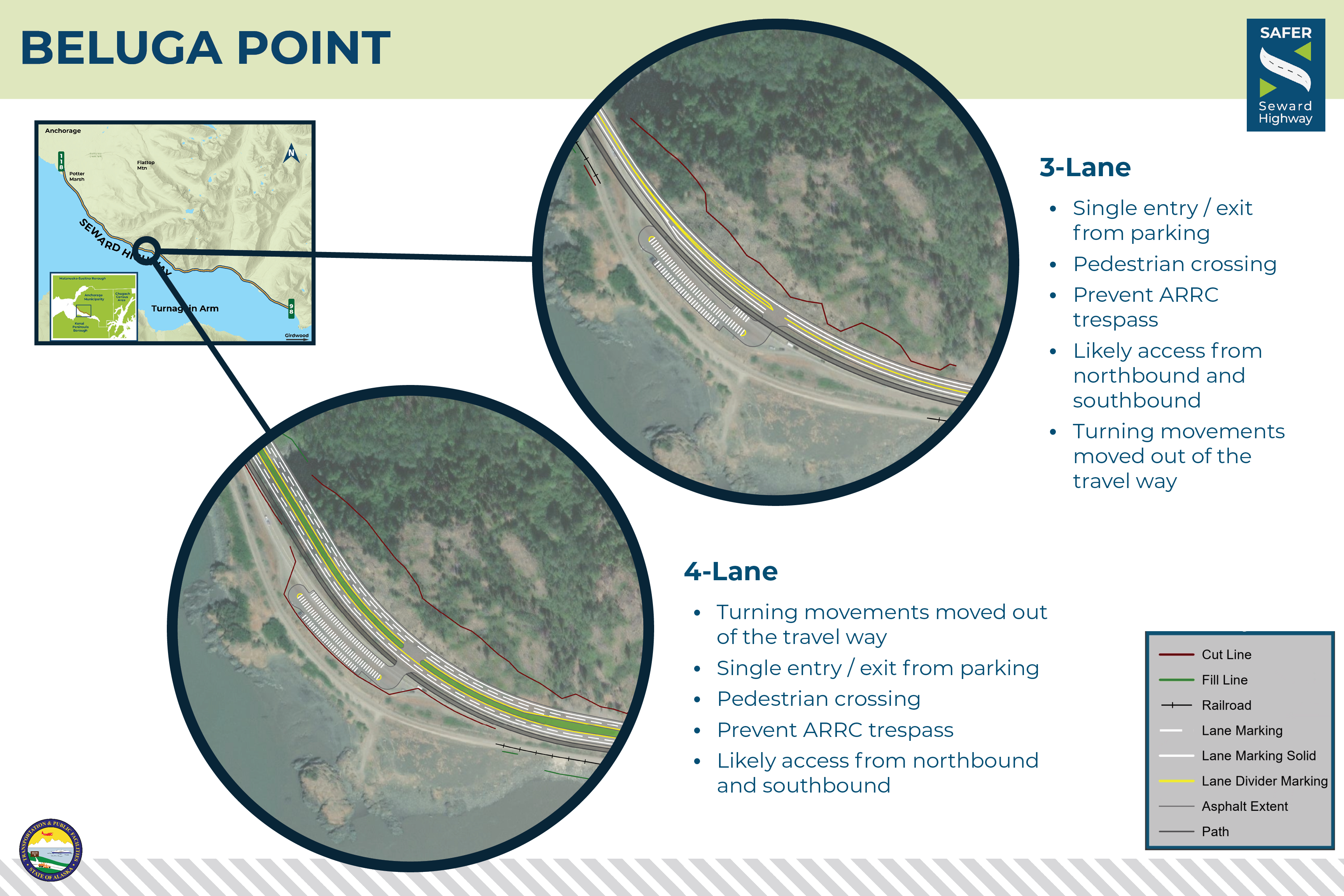
Beluga Point
The Beluga Point pinch point shows a diagram comparing 3-lanes and 4-lanes in the area.
3-Lane
- Single entry / exit from parking
- Pedestrian crossing
- Prevent ARRC trespass
- Likely access from northbound and southbound
4-Lane
- Turning movements moved out of the travel way
- Single entry / exit from parking
- Pedestrian crossing
- Precent ARRC trespass
- Likely access from northbound and southbound
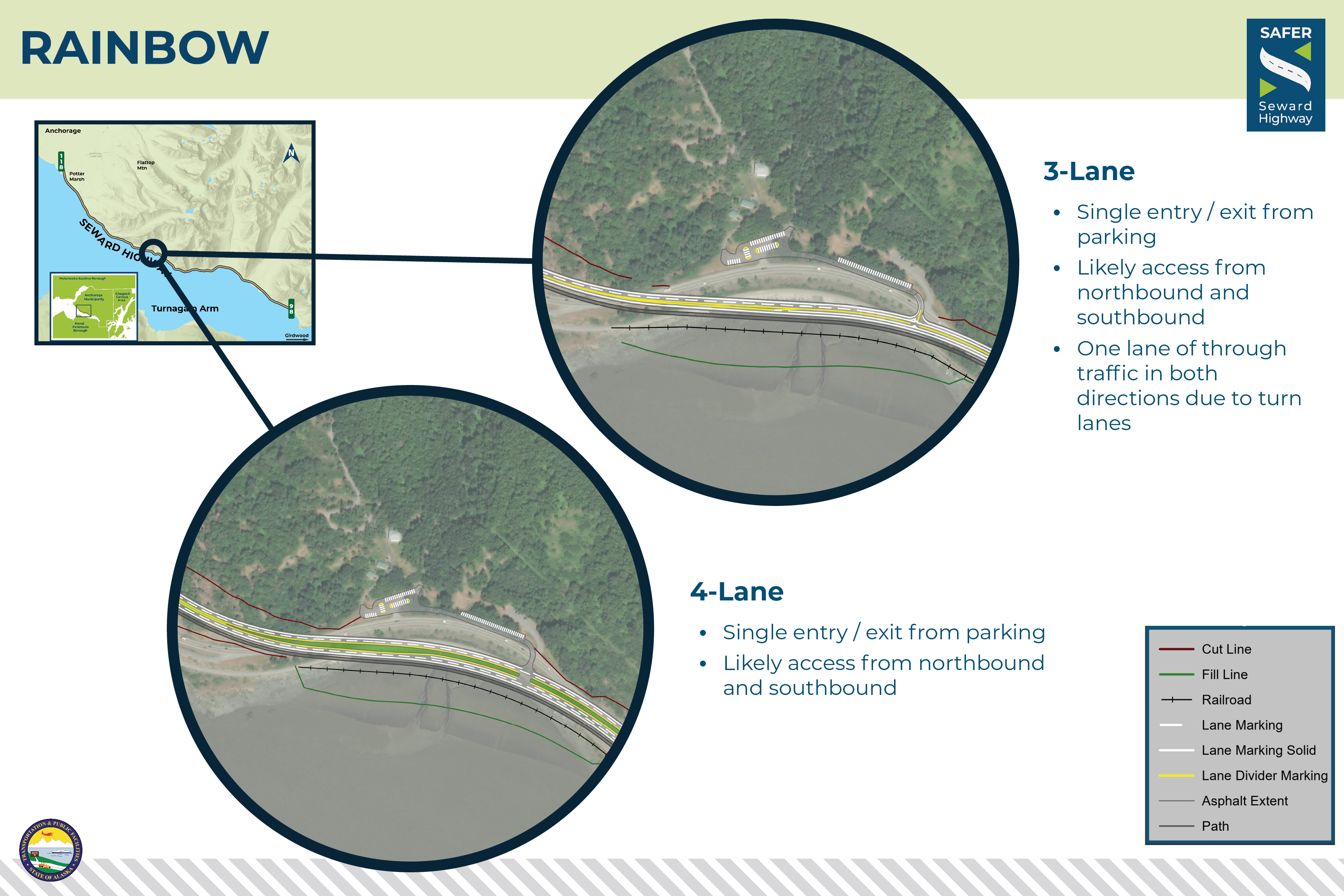
Rainbow
The Rainbow pinch point shows a diagram comparing 3-lanes and 4-lanes in the area.
3-Lane
- Single entry / exit from parking
- Likely access from northbound and southbound
- Turning lane take the additional through lane
4-Lane
- Single entry / exit from parking
- Likely access from northbound and southbound
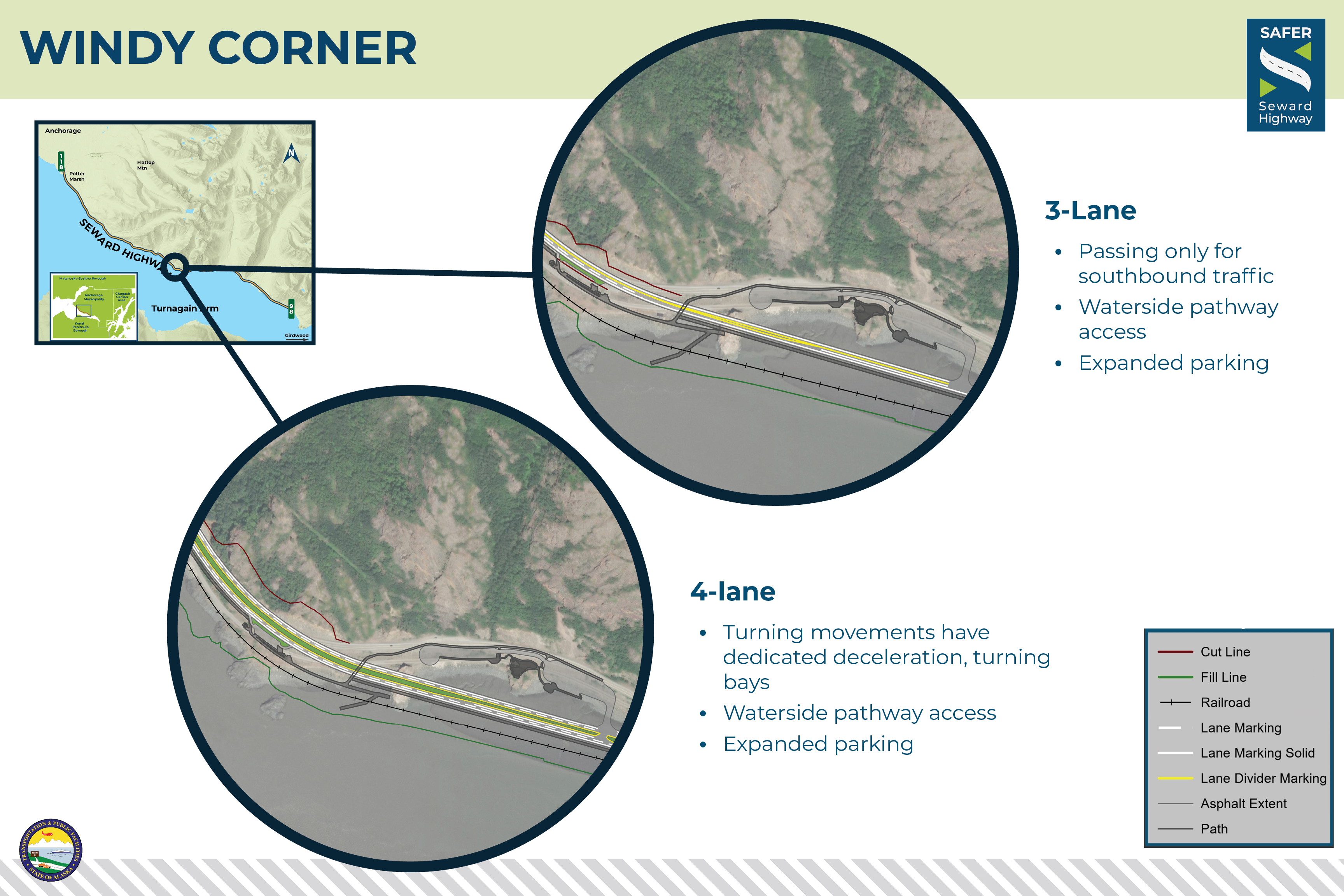
Windy Corner
The Windy Corner pinch point shows a diagram comparing 3-lanes and 4-lanes in the area.
3-Lane
- Passing only for southbound traffic
- Waterside pathway access
- Expanded parking
4-Lane
- Turning movements have dedicated deceleration, turning bays
- Waterside pathway access
- Expanded parking
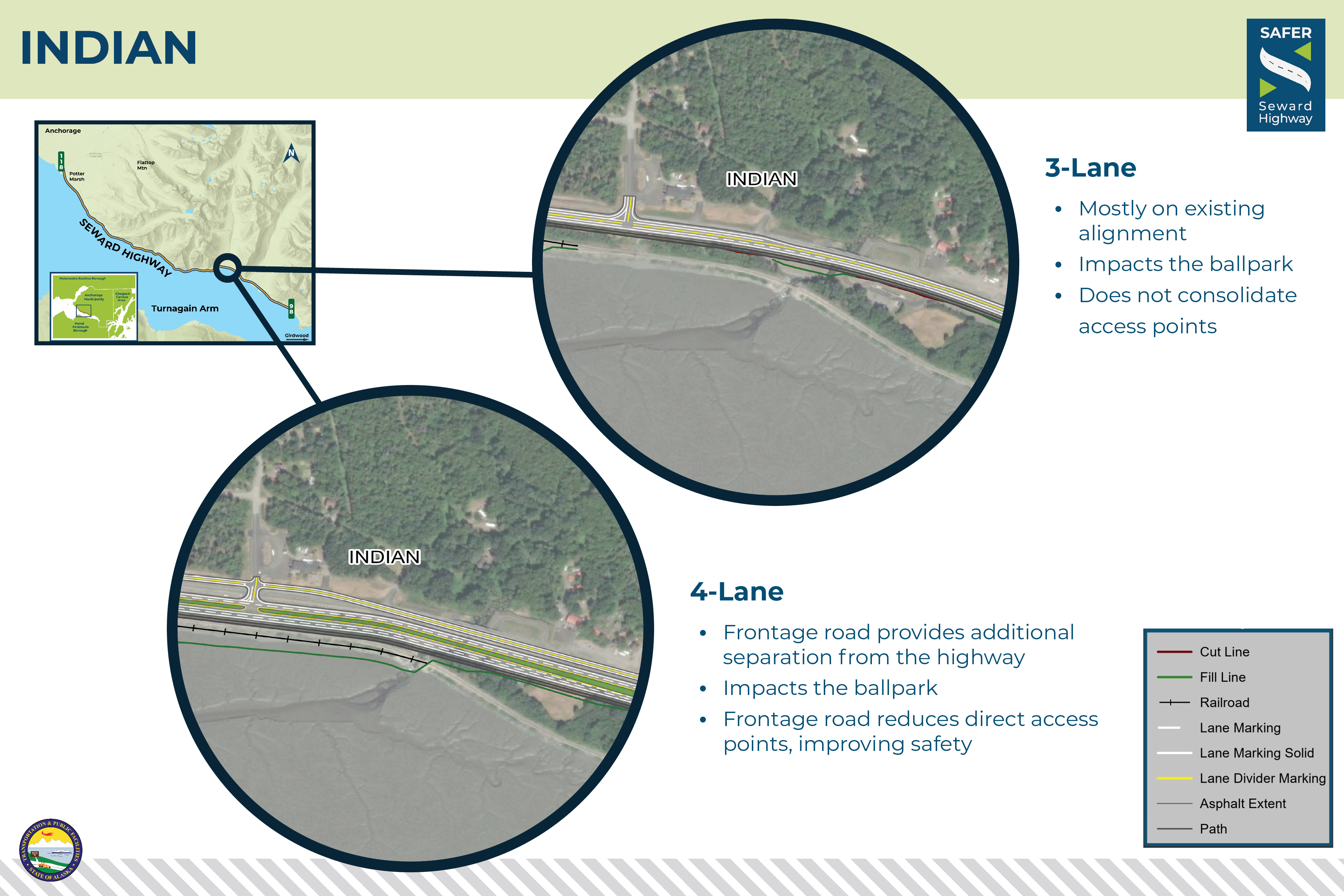
Indian
The Indian pinch point shows a diagram comparing 3-lanes and 4-lanes in the area.
3-Lane
- Mostly on existing alignment
- Impacts the ballpark
- Does not consolidate access points
4-Lane
- Frontage road provides additional separation from the highway
- Impacts the ballpark
- Frontage road reduced direct access points improving safety
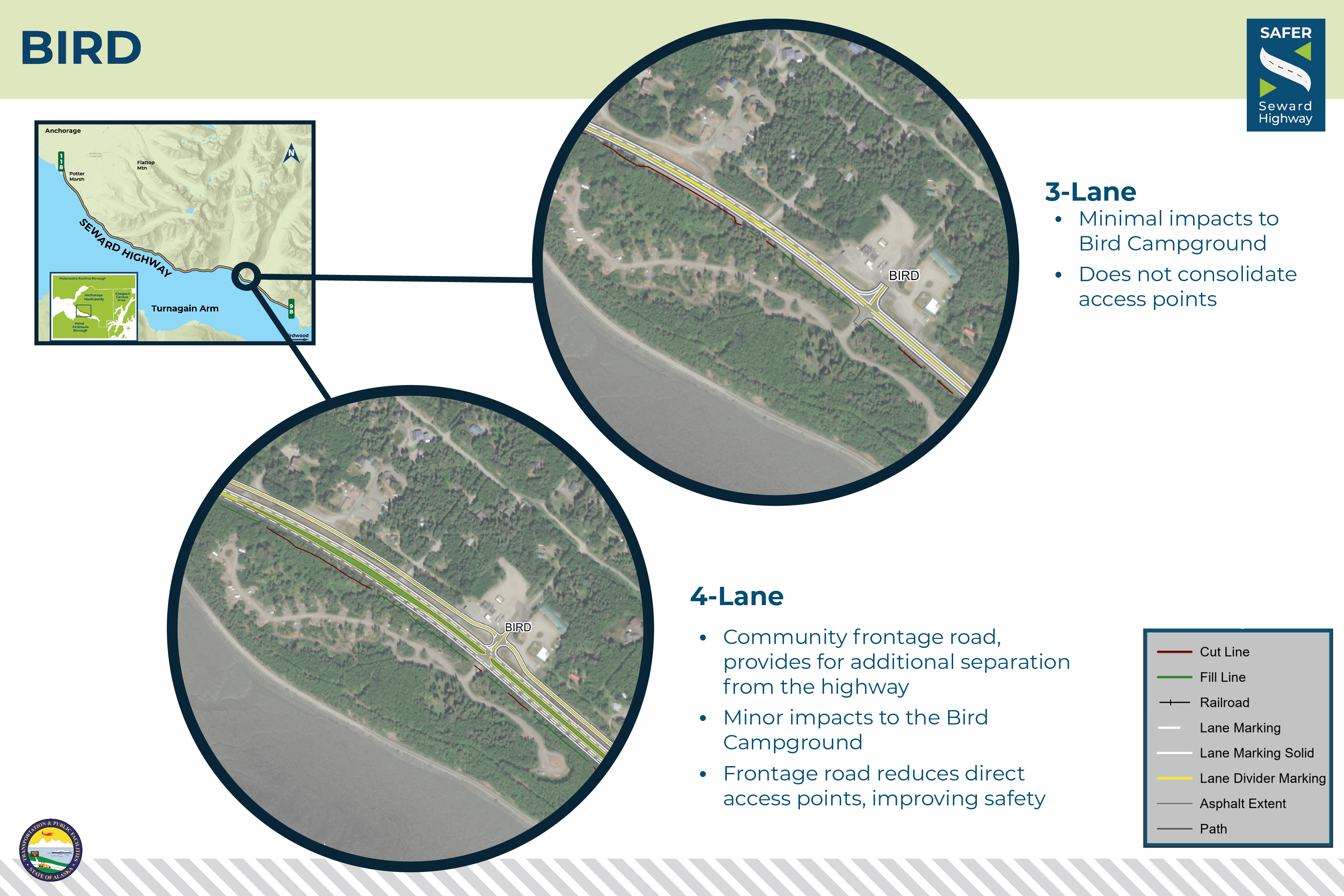
Bird
The Bird pinch point shows a diagram comparing 3-lanes and 4-lanes in the area.
3-Lane
- Minimal impacts to Bird Campground
4-Lane
- Community frontage road, provides for additional separation from the highway
- Minor impacts to the bird campground
- Frontage road reduced direct access points, improving safety
Screening Discussion
You might be asking “Now where do we go from here?” This meeting is the result of the top part of our screening process: we’ve examined concepts and ideas based on input from you, agencies, past studies, and a hard look at the existing constraints. We are currently working through the “screening factors” that you see in the top orange box. The end goal of this part of the project is to select a preferred alternative in the Final EA. This will support getting the required agency permits listed in the second orange box. If we decide to build something, then the project will move into the design phase, where we will finalize the engineering and details.
Once all that is complete, we can begin construction.
Timeline
We have now progressed to about halfway through the EA process. After getting your feedback on these concepts, we will begin our study of how the project may impact the natural, physical and human environment. The analysis will be presented in the Draft EA next fall for your input and comment. We will revise the document based on public and agency input, and plan to publish a Final EA in early 2025.
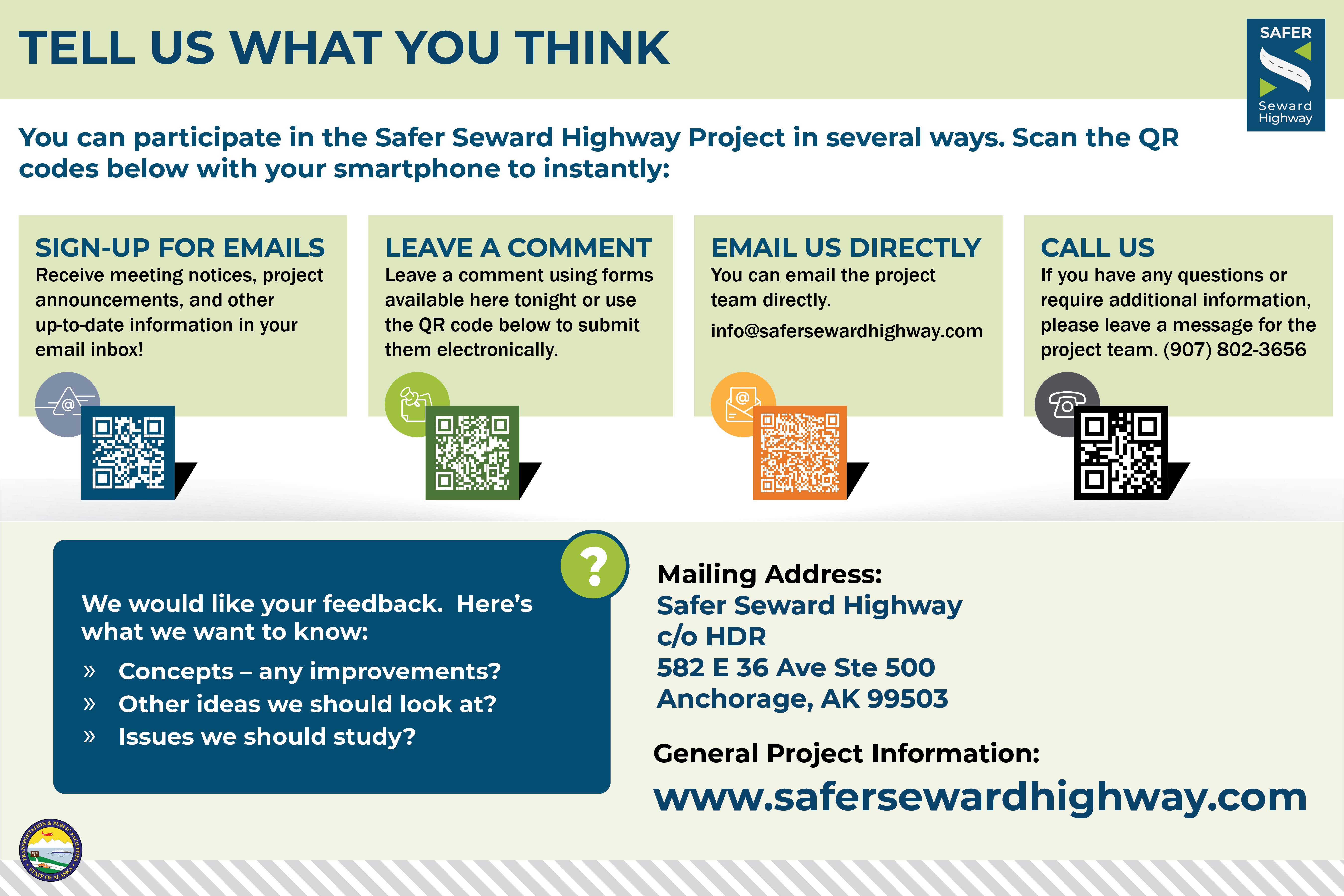
Tell Us What You Think!
You can participate in the Safer Seward Highway Project in several ways. Scan the QR codes with your smartphone to instantly:
Sign up for emails: You can receive meeting notices, project announcements, and other up-to-date information via email: http://eepurl.com/ih4q3n
Leave a comment: You can leave a comment using forms available here tonight or use the QR code below to submit them electronically: https://form.jotform.com/230466754071052
Email us: You can email the project team directly at [email protected].
Call us: If you have any questions or require additional information, please leave a message for the project team at (907) 802-3656.
Mailing Address
Safer Seward Highway
c/o HDR
582 E 36th Ave., Ste 500
Anchorage, AK 99503
Meeting Document Library
Below are the documents featured at the Spring 2023 Public Meetings. Acrobat Reader is required to view the documents below. You may obtain a free version of the program by visiting get.adobe.com/reader.
The environmental review, consultation, and other actions required by applicable federal environmental law for this project are being, or have been, carried out by DOT&PF pursuant to 23 U.S.C. 327 and a Memorandum of Understanding dated April 13, 2023, and executed by FHWA and DOT&PF.
